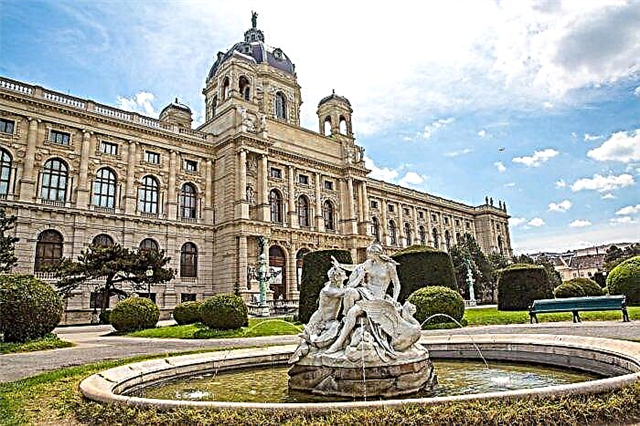Obtaining a diploma from one of the Austrian higher education institutions is the first step towards a successful professional career. That is why thousands of applicants from abroad are admitted to Austrian universities every year. The number of foreign students in some universities in the country is approaching the number of Austrian students.

Austrian educational system
It is not compulsory for children to attend preschool in the Republic of Austria. Parents, at their discretion, can send a child who has reached the age of 3 to a private or public kindergarten. It is noteworthy that all preschool institutions are paid.
The education system in Austria includes school and higher education. Children go to school at the age of 6.
The first 4 grades are primary school (Volksschule). Upon completion, you can choose one of two types of schools: secondary general education (8 classes) or basic (5 classes).
You can also go to a gymnasium (classical or real) - a more prestigious type of school.
There are three levels of higher education in Austria. These are bachelor's, master's and doctoral studies. Depending on the chosen specialty, bachelor's degree studies last 3-4 years, master's programs - 1-2 years, doctoral studies - at least 3 years.
Types of Austrian higher education institutions
 Based on the form of ownership, universities in this country are classified as follows:
Based on the form of ownership, universities in this country are classified as follows:
- Austrian state universities (Universitäten);
- private universities (Privatuniversitäten).
Almost all universities here are state-owned. The number of private higher education institutions in Austria is about ten.
In addition to classical universities, there are universities of applied disciplines (Fachhochschulen) in the country. Unlike the first ones, the second ones are aimed at passing long-term practical training by students in the chosen specialty. In this regard, bachelor's programs at universities of applied disciplines are designed not for 6 (as in ordinary universities), but for 7-8 semesters.
The procedure for admission to universities in Austria
Before entering an Austrian university for such specialties as chemistry, physics, geography, biology, mathematics, history, you will have to pass an introductory test. Enrollment in state universities for other specialties is carried out without entrance examinations.
One of the main requirements for foreign applicants is the presence of a certain level of language proficiency. In the undergraduate program, all disciplines are taught primarily in German. Among the master's programs there are also English-language ones.
To study in German, you must have at least level B2.2 (confirmed by the TestDaF certificate). When applying for an English-language program, you need to score at least 6 points in IELTS. The higher the level of language proficiency, the greater the chances of being enrolled in the university.
Russians who graduated from the 11th grade of school at home can immediately enroll in the so-called zero course of Austrian universities. It is designed for 2 semesters.
Here you can undergo the required language training, after which you can pass an international exam, as well as deepen your knowledge of core disciplines. Zero-year students are usually reserved for university places in their first year.
For some specialties (for example, economics, sports, creative professions), foreigners are enrolled immediately after school.
Those citizens of Russia who have studied at the university for 1-2 years in their chosen specialty have the right to enroll in educational institutions in Austria, bypassing the preparatory department.
List of documents
You can start your studies at an Austrian university either from the winter or from the summer semester. The first one starts on October 1, and the second one on March 1.
Acceptance of documents opens 6 months before the start of classes. Those who plan to study from the winter semester must have time to submit the package of official papers by September 5, from the summer semester - until February 5.
The list of documents consists of:
- applications with a completed questionnaire;
- motivation letter;
- a certificate (for a bachelor's degree) or an existing diploma (for a master's degree) with an attachment (documents must be translated into German and apostilled);
- certificates about the disciplines listened to and marks for them for those who enter after 1-2 courses of Russian universities;
- certificates confirming the availability of the required level of proficiency in German, English;
- health insurance policy;
- copies of the foreign passport.
Austrian universities for foreigners may put forward additional requirements. The decision on this is made by the administration, after which a notification letter is sent to the applicant by e-mail.
Leading Austrian Universities
Below is a list of the largest universities in the country with a brief background information about each.
Universität Wien (University of Vienna)
 The University of Vienna is the oldest university in the country. The year of its foundation is 1365th.
The University of Vienna is the oldest university in the country. The year of its foundation is 1365th.
For many years this university has been leading in Austria in terms of the number of students: over 92 thousand, of which about 30% are foreigners.
The University of Vienna is annually ranked among the top 100 best universities in the world. 15 of its graduates became Nobel Prize winners. It houses the largest library in Europe, where more than 1.5 million books are kept, including old manuscripts.
The educational institution has 18 faculties, which offer applicants 54 bachelor's, 112 master's and 11 doctoral academic programs. The most prestigious areas are medicine, biology, humanities. Here you can also get a spiritual higher education by enrolling in a Catholic or Protestant faculty.
Education in universities in Austria, which are state-owned, is free of charge.
Universities charge only semester fees. Their amount at the University of Vienna, as in all those listed below, for citizens of countries outside the European Union is 726.72 euros.
Universität Innsbruck (Leopold and Franz University Innsbruck)
 The University of Innsbruck was granted the status of a higher educational institution in 1669 by the decree of King Leopold I. Up to this point, the institution functioned as a Jesuit grammar school.
The University of Innsbruck was granted the status of a higher educational institution in 1669 by the decree of King Leopold I. Up to this point, the institution functioned as a Jesuit grammar school.
After some time, the University of Innsbruck was turned into a lyceum. But in 1826, Emperor Franz II returned it to its former status.
The university is the largest university in the federal state of Tyrol. There are more than 26.5 thousand students here. Of these, about 34% are citizens of other states.
The university consists of 15 faculties. Physics is considered one of the strongest directions. The main part of the university budget is spent on its development.
Technische Universität Wien (Vienna Technical University)
 Vienna Technical University was founded in 1815. Included in the top 100 most prestigious technical universities in the world. It is considered the most successful technical university in Europe, collaborating with large corporations and taking part in cutting-edge scientific research. More than 28 thousand people receive higher education here (19% are foreigners).
Vienna Technical University was founded in 1815. Included in the top 100 most prestigious technical universities in the world. It is considered the most successful technical university in Europe, collaborating with large corporations and taking part in cutting-edge scientific research. More than 28 thousand people receive higher education here (19% are foreigners).
The educational institution has 8 faculties and 56 institutes. Within their limits, there are 21 undergraduate departments, 43 graduate departments and 3 doctoral departments.
The most demanded specialties are computer technology, mathematics, technical chemistry, energy, architecture, mechanical engineering.
Karl-Franzens-Universität Graz (University of Graz)
 The University of Graz is the second largest university in Austria. It has been operating since 1585. Has released 6 Nobel laureates. Today, over 32 thousand students study here, among whom the share of foreigners is 10%.
The University of Graz is the second largest university in Austria. It has been operating since 1585. Has released 6 Nobel laureates. Today, over 32 thousand students study here, among whom the share of foreigners is 10%.
Structurally, the university consists of 6 faculties.Previously, it trained doctors, but since 2002, the Faculty of Medicine has been transformed into a separate Medical University of Graz.
The leading faculties of the university are the faculties of natural, as well as economic and social sciences.
Johannes Kepler Universität Linz (Johannes Kepler University)
 The Johannes Kepler University has been operating since 1966 in the city of Linz. During its relatively short existence, it has become one of the best universities in Austria.
The Johannes Kepler University has been operating since 1966 in the city of Linz. During its relatively short existence, it has become one of the best universities in Austria.
Today the university is distinguished by the most powerful material and technical base, the presence of cooperation agreements with more than 300 universities in 40 countries of the world.
The institution was included in the Times Higher Education 100 Under 50 ranking of the youngest universities in the world.
The official website of the Johannes Kepler University indicates that over 19 thousand students study here. Structurally, the university consists of 4 faculties and 120 institutes, offers applicants 18 bachelor's, 35 master's, 1 candidate's and 5 doctoral academic programs.
This institution of higher education occupies a leading position in the country in the field of distance learning, including online. It is the only Austrian university to introduce a multimedia degree program in law. In 2021, the Faculty of Medicine opened here, and its popularity is growing rapidly.
Medizinische Universität Wien (Medical University of Vienna)
 The Medical University of Vienna was founded in 1365 as the Faculty of Medicine of the University of Vienna. It was reorganized into an independent higher educational institution in 2004. Now it has about 8 thousand students.
The Medical University of Vienna was founded in 1365 as the Faculty of Medicine of the University of Vienna. It was reorganized into an independent higher educational institution in 2004. Now it has about 8 thousand students.
Like other universities in Vienna, it abandoned outdated academic programs, and instead introduces more progressive ones. Therefore, the popularity of the university is growing every year. The share of foreign students in it exceeds the share of Austrians.
There are 31 clinics and 12 medical theoretical units under the patronage of the university. Every year, university medical institutions carry out up to 48 thousand operations, treat about 100 thousand inpatients and 605 thousand outpatients. Leading directions - biomedicine, oncology, transplantology, neurosurgery.
Alpen-Adria-Universität Klagenfurt (Alpine-Adriatic University of Klagenfurt)
 The Alpine-Adriatic University of Klagenfurt has existed since 1970. It has the status of the largest scientific and research center in the state of Carinthia.
The Alpine-Adriatic University of Klagenfurt has existed since 1970. It has the status of the largest scientific and research center in the state of Carinthia.
More than 11 thousand students study at the university. Structurally, the university consists of 4 faculties, within which 33 institutes are allocated.
Popular areas - economics, information technology, applied informatics, management, business management. The university supports multilingualism by offering programs for members of the Slovenian ethnic minority.
Universität Salzburg (University of Salzburg)
 The University of Salzburg began its work in 1622. It is one of the oldest institutions of higher education in Austria. Today more than 18 thousand students are educated here.
The University of Salzburg began its work in 1622. It is one of the oldest institutions of higher education in Austria. Today more than 18 thousand students are educated here.
The structure of the university has four faculties: law, natural sciences, cultural studies and social sciences, Catholic theology.
Many foreigners, including Russians, aspire to travel to Austria to enter the University of Salzburg. They study history, art, languages here.
Other Austrian universities
The list of popular state universities of the country among foreigners also includes:
- Wirtschaftsuniversität Wien - Vienna University of Economics.
- Akademie der bildenden Künste Wien - Vienna Academy of Fine Arts.
- Veterinärmedizinische Universität Wien - Veterinary University of Vienna.
- Universität für Bodenkultur Wien - Agricultural University of Vienna.
- Technische Universität Graz - Technical University of Graz.
- Medizinische Universität Graz - Medical University of Graz.
- Montanuniversität Leoben - Mining University of Leoben.
Among the well-known private educational institutions of the country are Webster's Vienna campus (Webster University), MODUL University Vienna (MODUL University).
Summarizing the above
Obtaining higher education in Austria is a chance to become the owner of a diploma recognized not only in Europe, but also far beyond its borders, including Russia, USA, Canada. And this, in turn, will open up a prospect for a specialist to find a well-paid job and build a successful career abroad.
Among the advantages of studying at Austrian universities, one should also note the absence of entrance exams, the opportunity for foreigners to enroll in some specialties immediately after leaving school in their homeland, and low fees for educational services.
The main disadvantages of studying in Austria are the lack of free rooms in dormitories, high language requirements for foreign applicants, a complex exam system (in this country, students independently make up exam schedules and the pace of passing modules in disciplines).











